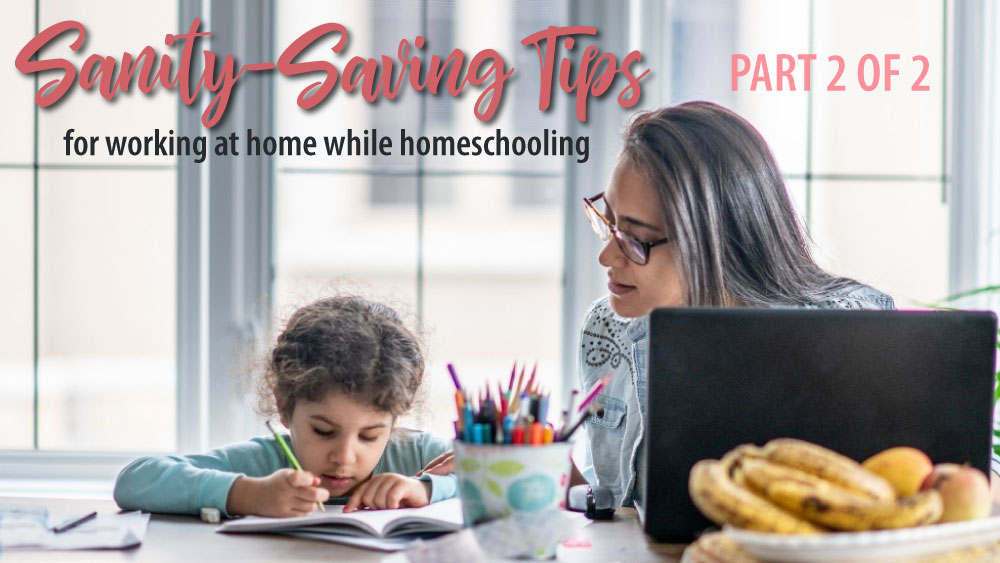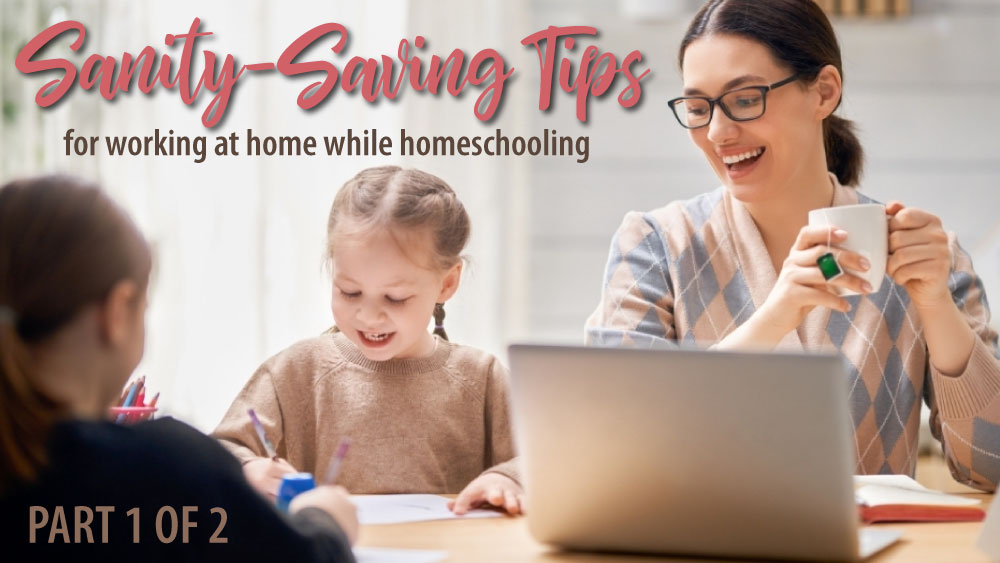It’s one thing to decide that you are going to homeschool your children and another thing altogether to decide that you are going to homeschool your children while attempting to work from home.
Even if you're not trying to run a business or hold a job while staying at home and homeschooling, you may be finding it a struggle to get things done while having your children with you all day long.
Homeschool Iowa team members, Jenn and Julie,
offer these sanity-saving tips
to help you navigate through the challenges
of working at home while homeschooling.
Included throughout, you’ll find bonus real-life insights and examples from Jenn and Julie.
Let’s start by briefly looking at some special considerations for homeschooling when combined with working at home.
Design Your Homeschool Plan
Hopefully you've had time to set out a plan for your children's homeschool instruction. Homeschool Iowa offers an online Start Homeschooling guide with everything you need to begin your adventure.
However, if you've found yourself turning to home education in response to sudden circumstantial changes, here are a few FREE homeschooling resources that can help with a quick start:
- Ambleside Online's Emergency Lesson Plans
- An Old-fashioned Education
- Easy Peasy All-in-One Homeschool
- Khan Academy
- Plain and Not So Plain
- Under the Home
When facing the additional challenge of combining homeschooling and working at home, it’s okay to consider using prepared curriculum resources, correspondence schools, or online programs. Customizing curriculum for each child and each subject is a laudable goal, but that can be very time-consuming.
Packaged curricula is often “open-and-go” so you don’t have to search for outside resources. Some correspondence and online programs offer video or digital instruction as well. All of these options usually include prepared instructor guides and schedules that help take the stress out of homeschool planning.
Prioritize Time & Subjects
Dedicate a designated time within your day for you and your children to exclusively focus on homeschooling. The best time for this will likely be in the morning, but set it whenever works best for your particular family situation. If you have more than one child, try to start with something that includes everyone — perhaps Bible study, a brief selection from a read-aloud book, or a short discussion of a current event.
Prioritize key subjects during your designated homeschool instruction time. Reading, language arts, and mathematics will be your top focus, especially in the early grades. Younger children will need more direct instruction, while older kids can work independently.
Real-Life Insights from Julie
For many years, I started our homeschool morning with Bible study, using Bible Study Guide for All Ages. (Keep in mind that I've homeschooled nine children for over 30 years. There are many other quality options available now.) Beginning the day with Scripture got us off to a good start.
During the years I was teaching many children of different ages, we studied history together as a family, reading about history as a group and then following up with grade-level-appropriate projects.
Once our older children were able, they could help the younger ones with simple tasks, like reviewing flashcards or reading off spelling words.
Now let’s turn to tips on combining homeschooling and working at home.
Embrace a “New Normal”

Once you make the decision to combine homeschooling and working at home, your schedule, plans, routines, and expectations will probably change radically. Embrace that as a potential blessing and brainstorm with your family ways to build a “new normal.”
Family members will maneuver through the needed transitions and adjustments much more smoothly when everyone is involved with the process.
As you work together to find your family’s “new normal,” make sure you focus on building and maintaining strong relationships. Learn to speak their love languages, and let them know frequently that they are more important than your job.
Explore Creative Alternatives
As your family brainstorms ideas, you’ll likely come up with novel solutions to meet your specific challenges. If possible, try thinking outside the typical “9-to-5" framework. If some of your workload can be shifted to early morning, later evening, or part of a weekend, you can consider doing that.
If you share parenting responsibilities with a spouse, you might set up a cooperative schedule for work and homeschooling. Perhaps Mom and Dad can work different shifts, taking on parenting and homeschooling in different parts of the day. Or you might consider cooperative teaching arrangements with other work-at-home parents who are homeschooling children of similar ages as yours.
Maybe you can look for alternatives, like having Grandma or another close family member or friend care for your kids during a concentrated work time. You might even allow yourself to hire help if you are financially able. Some working parents are joining with other working parents to hire a licensed teacher to provide direct instruction for their children.
There are many options available. You can find the one that works for your family.
Consider Surroundings

Keep in mind that our physical environment impacts our behavior and productivity. With everyone at home — often working on different things at the same time — this is even more important.
Do you need to convert an underused space into a work area? Do your children need designated spots for play or independent schoolwork where they can be monitored but non-distracting when a work task arises for you?
Another important factor that affects mood and behavior is our outward appearance. While both you and your children can wear comfortable clothing, you probably will not be as productive wearing a bathrobe and slippers all day. Encourage the whole family to start each day “dressed for success” – whatever that looks like for you.
Real-Life Insights from Julie
When I still had very young learners, I often needed to sit next to them at the kitchen table with my laptop while they worked on schoolwork.
As our children aged, they gravitated to favorite spots around the house to work independently.
Several years ago, I found an amazing piece of furniture online that I purchased at a deep discount. It has a fold-down desk with room for my laptop and the second screen I use, and it also has a file drawer, a storage space behind a small door, and several shelves. When company comes, or grandchildren are visiting, I can close up the fold-down desk to hide my work area.
Designate Realistic Boundaries
It’s especially important to guard against overcommitment when you’re juggling homeschooling, work, and home duties. The reality is that both you and your children will need to limit outside activities. That means family members will need to focus on only one or two things about which they’re passionate.
When possible, look for activities that can include the whole family. And, when considering outside commitments, make sure your family’s needs are met first.
Real-Life Insights from Jenn
• Sometimes a friend or family member will call and say, “Hey, since you’re home all day could you do [XYZ] for me?” Without guilt, I say, “I’m so sorry, but our schedule is already set and I can’t make that happen for you.” I do try to serve my friends and family by helping them out when possible, but the fact that I’m home all day does not mean that I’ve got time to take care of all the things for everyone.
• We limit the kids' extracurricular activities that occur outside of the home. This is a hard one, but it’s been essential to keeping our family calendar manageable. We look for bonus activities that everyone will enjoy, and we do those. We intentionally stay home at least three days a week with no outside excursions. When there are five or six exciting things we could do away from home in a week, we pick one or two.
• We group errands so that we can leave the house once and take care of three or four things in the same outing. We also don’t go grocery shopping until the afternoon, after all of the work is done for the day.
Set Clear Expectations

Let’s be realistic. There is no way you can work, homeschool, prepare meals, do the laundry, and keep a perfectly clean house all by yourself. That means you’ll need to enlist your family team, designating chores and responsibilities for your kids with clear instructions. No mind-reading expectations on what needs to be done.
For this sanity-saving tip, a white board or checklist will be your best friend! Teach your kids to use a daily to-do list while they are young, and they will forever be grateful to you as they get older. And if you too use a written prioritized list, you won’t have to worry about forgetting something important either.
Real-Life Insights from Jenn
I use a weekly checklist for our family with any scheduled activities or appointments on it, along with our daily cleaning schedule. We clean a different area of the house each day so that, at the end of the week, we’ve cleaned the whole house.
As each task is completed, we check them off the list. We've never used reward programs because these tasks were simply “be a good human” habits that they needed to develop.
I try to write out my to-do list for the next day each night before I go to bed so that I know what I need to accomplish the next day during my work time blocks. I use assignment notebooks for the kids so that they know what lessons and projects they need to do each day.
When my kids were young, I printed assigned daily task charts illustrated with free clip art on sheets hung on their bedroom doors. Now that my kids are older, we've switched to chore cards with the steps for each chore included.
We have a laundry card, a bathroom card, a cleaning-the-floors card, and – their least favorite – a clean-your-room card that includes “DO NOT SHOVE THINGS UNDER YOUR BED!” And, yes, those words are printed in capital letters!
Provide Ground Rules
The reality of working from home while homeschooling will mean that, at some points during the day, you’ll need to be on the phone or otherwise unavailable for consultation or conversation.
How can you help your children recognize those instances and react appropriately?
You can institute a visual signal or “insider” family gesture that will act as a cue. Along with this cue, offer your children options to use when they need to wait for your attention. Here are some suggestions:
• Provide a “Help Me Later” spiral notebook or small white board for older children to briefly write what they need help with at a later time. (Make sure to check it and follow through!)
• Create a “Do While I’m Waiting” folder with simple items that can be worked on while you’re unavailable. These can be ongoing projects that your child has started with you but can be worked on independently afterward.
• Have some art or craft supplies available for kids to use when you’re temporarily engaged with something work-related.
Real-Life Insights from Jenn
My kids know that if I’m on the phone for work and they try to ask me a question, the answer is automatically “No!”
They also know, during certain times of the day when I’m working and they’re supposed to be doing schoolwork, not to interrupt me for anything less than bones sticking out of their skin or blood spurting from their veins.
More TIPS For You

Part 2 of our "Sanity-Saving Tips for Working at Home While Homeschooling" covers nine additional topics.
If you have tips you'd like to share, add them to the comments section below.



